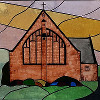“Come” he replied to two of John-the-Baptist’s followers; ‘and you will see.” John 1:39
Do you remember those times, when you were a child, when you were so excited about some discovery that you had made that you just had to get someone else to share in your excitement as well? Even if like Nathaniel, they took some persuading.
In John’s Gospel account of Jesus’ calling of his disciples you can still sense the excitement of those first disciples. I have this sense of Andrew almost dragging his brother Simon to meet Jesus; and then Simon, who had initially been reluctant to meet the wandering preacher being bowled over when he realised who the preacher actually was - and then he is totally shocked when Jesus calls him ‘petros’ - the rock! His rock!
Andrew had seen who Jesus was and led Simon to see him too. Can you imagine their excitement in coming face to face with the promised Messiah? We get the sense of this excitement in John’s writing but what would it have been like to meet Jesus in real life? And, what was it that these men saw in him?
John uses a strange phrase to describe Jesus; ‘The Lamb of God’ (1:36), a phrase that today we hardly notice and if we do, our thoughts are most likely of fluffy wee white or occasionally black or brown creatures happily gambolling in Springtime fields. A pretty but hardly powerful image. The image John is trying to convey is certainly not fluffy, his is of sacrificial offering.
Ritual slaughter or sacrifice was a big part of the Hebrew religious practice. Lambs without ‘spot or stain’ were used as offerings to God. When the Jews sacrificed and animal they would first place their hands on the animals head, then take them away as they slit its throat. They believed that as they placed their hands on the animals’s head their sins passed into the creature and thus when it was sacrificed it carried or took away their sins. Hence the meaning of the Angus Dei in the Eucharist:
“Lamb of God, you take away the sins of the world, have mercy on us.”
Ritual sacrifice was big business in Jesus’ day and when John-the-Baptist refers to him as the ‘Lamb of God’ ordinary folk would have instantly recognised what he meant. However, they would not have expected the phrase to be associated with a human being, least of all the long promised Messiah. John’s picture of Jesus is a harsh one. The salvation he comes to offer us comes at a great price, his life in atonement for OUR sins.
The Russian author Dostoyevsky encapsulates what this means in his novel ‘The Brothers Karamazov’:
“The righteous man departs, but his light remains. People are always saved after the death of him who came to save them. Men do not accept those whom they have tortured to death.”
Quite what those called to be disciples expected to see when they were challenged to ‘turn and see the Lamb of God’ we do not know but what we do know is that they saw in Jesus something that them follow him. They saw enough to desire to be taught by him, to give up everything for him, to bring others to listen to him and to be (eventually) prepared to die for him, as well.
Andrew tells Simon to ‘see the Messiah’ and like the phrase ‘the Lamb of God’ both phrases would have been mind blowing to first century Jews. In the 21st century these words have lost much of their power, perhaps we need to recapture something of what we have lost and give back to Jesus the amazingness of who He actually is and what He came to do.
This morning’s Gospel reading is one full of hope, full of potential. It speaks of new life, fresh starts, new beginnings and it also challenges us to take its message seriously; to proclaim again who Jesus is and what He means for us and for our salvation. If we can only encourage the world to take Jesus seriously we might actually be able to live in a better world.
